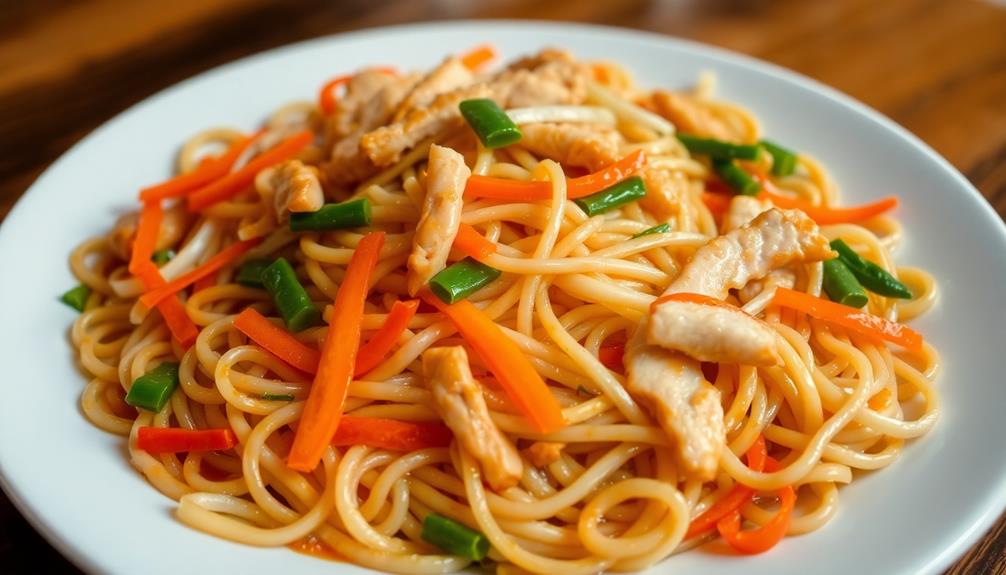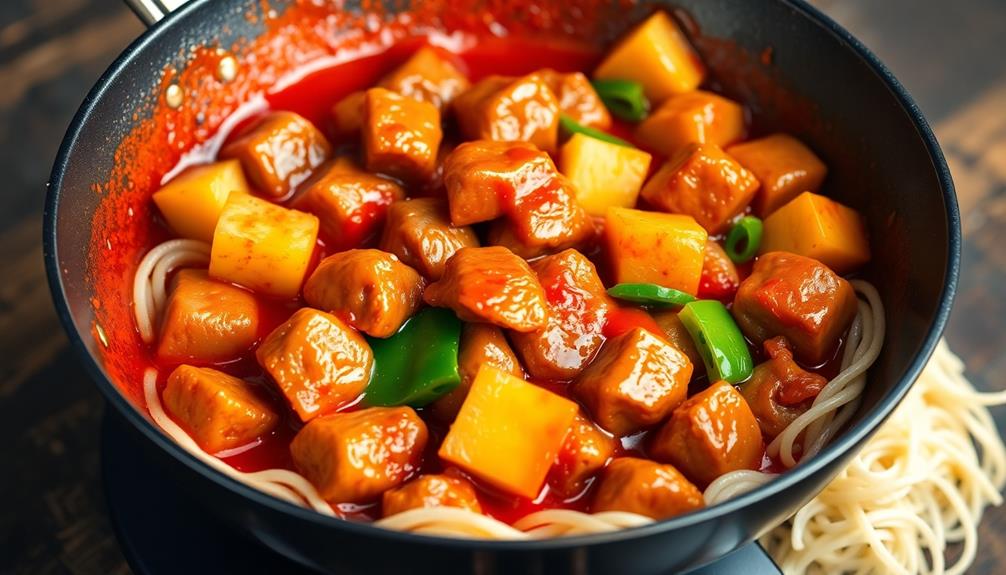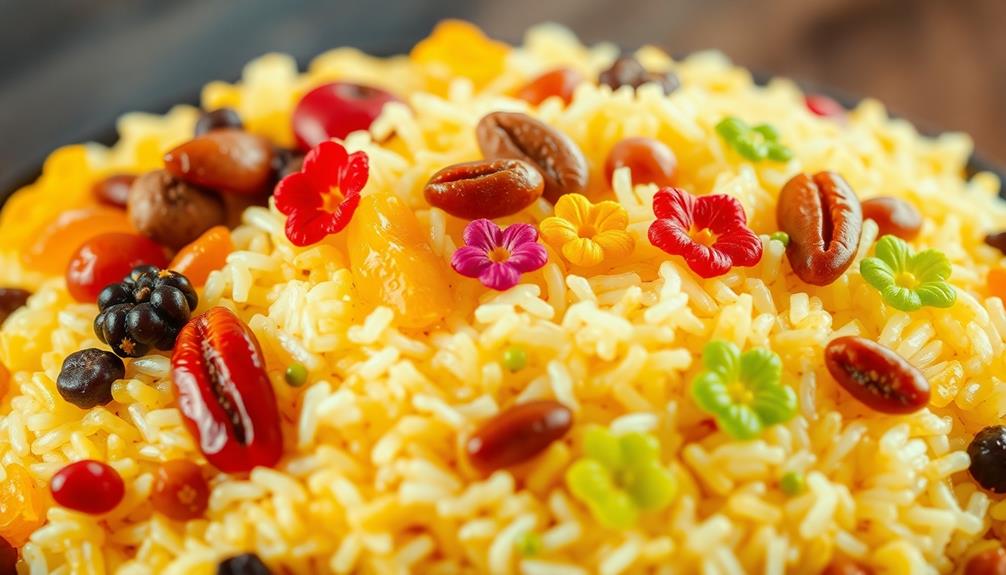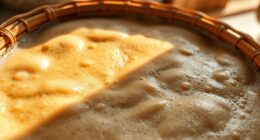Chow mein is the ultimate Chinese-American dish that'll have your tastebuds dancing with joy! It all started when Chinese immigrants brought their delicious noodle stir-fry to the U.S. in the late 1800s. Over time, it evolved to include American ingredients like cabbage and soy sauce, becoming a beloved staple enjoyed by all. The best part? You can customize it with your favorite veggies and proteins for a quick, satisfying meal. Just remember to stir-fry those crisp veggies, toss in the noodles, and serve it up hot – trust us, your family will be begging for seconds! Now, let's dive deeper into the flavorful history and mouthwatering recipe of this iconic dish.
Key Takeaways
- Chow mein is a Chinese-American dish featuring stir-fried noodles, vegetables, and protein, often customized with various ingredients and flavors.
- The dish originated in the late 19th century with Chinese immigrants in the U.S. and has since become a staple of Chinese-American cuisine.
- Chow mein can be prepared using fresh egg noodles, dried chow mein noodles, or even spaghetti, with key ingredients including soy sauce, sesame oil, garlic, and ginger.
- The cooking process involves stir-frying vegetables until tender-crisp, adding soy sauce and seasonings, and then tossing in the noodles to create a colorful, flavorful dish.
- Chow mein offers a satisfying, well-balanced flavor profile that combines salty, savory, and slightly sweet notes, making it a family-friendly and versatile meal option.
History
The origin of chow mein can be traced back to the late 19th century when Chinese immigrants brought their culinary traditions to the United States.
These early pioneers were eager to share their beloved noodle dishes, and chow mein quickly became a popular menu item in Chinese restaurants across the country.
Over time, the recipe evolved to cater to American tastes, with the addition of ingredients like cabbage, bean sprouts, and soy sauce.
Today, chow mein is a staple of Chinese-American cuisine, enjoyed by people of all ages and backgrounds.
Whether you prefer it with chicken, beef, or shrimp, this versatile dish continues to delight and satisfy.
Its enduring popularity is a testament to the rich cultural exchange that has shaped the diverse flavors of American food.
Recipe
Chow mein is a classic Chinese dish that features stir-fried noodles, vegetables, and protein. It's a quick and easy meal that can be customized to suit your taste preferences. Whether you're in the mood for a vegetarian version or one with chicken, beef, or shrimp, chow mein is a versatile and delicious option.
Additionally, enjoying a well-balanced diet can contribute to overall health and wellness, which is essential when considering dietary choices, such as foods beneficial for managing gout symptoms. Chow mein can be made with different types of noodles, including fresh egg noodles, dried chow mein noodles, or even spaghetti. The key is to choose a noodle that can hold up to the stir-frying process and absorb the flavorful sauce.
- Noodles (fresh egg noodles, dried chow mein noodles, or spaghetti)
- Protein (chicken, beef, shrimp, or tofu)
- Vegetables (cabbage, carrots, bean sprouts, onions, etc.)
- Soy sauce
- Sesame oil
- Vegetable oil
- Garlic
- Ginger
- Salt and pepper to taste
Start by boiling the noodles according to the package instructions. Drain and set aside. In a large wok or skillet, heat the vegetable oil over high heat. Add the protein and stir-fry until cooked through. Remove the protein from the wok and set aside.
Add the garlic and ginger to the wok and stir-fry for 30 seconds. Add the vegetables and continue to stir-fry until they're tender-crisp. Add the cooked noodles and the protein back to the wok. Pour in the soy sauce and sesame oil, and toss everything together until the noodles are well coated and heated through. Season with salt and pepper to taste.
For best results, be sure to have all your ingredients prepped and ready to go before you start cooking. This will allow you to move quickly and ensure that the chow mein doesn't become overcooked or soggy. Additionally, feel free to experiment with different vegetables and protein sources to find your perfect combination.
Cooking Steps
First, gather all your ingredients and get them ready to go – that's called "mise en place".
Then, you'll stir-fry the veggies until they're tender but still have a nice crunch.
Next, add some soy sauce and other tasty seasonings, and toss in the noodles.
Step 1. Prepare Ingredients Mise En Place
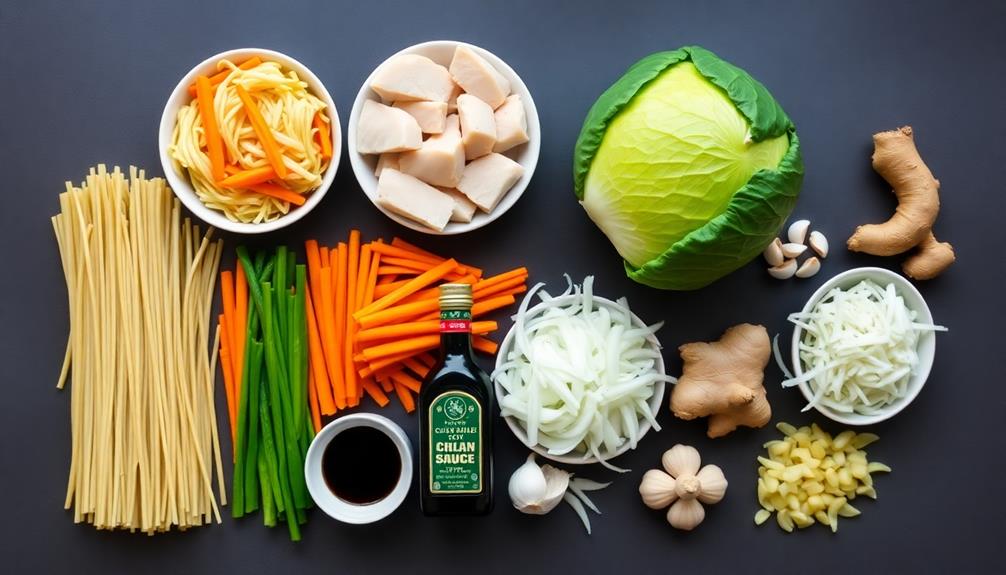
Begin by gathering all the necessary ingredients for your chow mein dish.
You'll need some fresh veggies like sliced cabbage, carrots, and scallions. Don't forget the protein – either chicken, beef, or shrimp will work great.
You'll also need some fresh garlic and ginger to add lots of flavor. Make sure to have soy sauce, sesame oil, and a bit of cornstarch on hand too.
Once you've got everything ready, let's start prepping! Thinly slice the cabbage and carrots so they'll cook quickly.
Mince the garlic and ginger – the more finely you chop them, the more they'll infuse the dish. Slice the scallions, keeping the white and green parts separate.
For the protein, cut the chicken, beef, or shrimp into bite-sized pieces.
With all your ingredients ready to go, you're one step closer to a delicious chow mein feast!
Just wait until you get a whiff of those savory aromas as everything sizzles in the pan.
Step 2. Stir-Fry Vegetables Until Tender-Crisp

Heat a large wok or skillet over high heat. Once it's sizzling hot, add a splash of oil and swirl it around to coat the surface.
Toss in the prepared vegetables – you've got crisp carrot coins, tender-yet-crunchy broccoli florets, and juicy strips of bell pepper. For an energizing start to your day, consider pairing these vibrant veggies with something protein-rich, like an Egg Rollup and Dumpling Sauce for a balanced breakfast.
Stir-fry the veggies, using your chopsticks or a spatula to keep them moving. You want them to sizzle and char up just a bit on the edges, but still retain that perfect tender-crisp texture. Don't overcrowd the pan – work in batches if needed so the veggies have room to brown.
Season with a pinch of salt and a sprinkle of white pepper. The aromas will start wafting up, making your mouth water. Keep stir-frying until the vegetables are cooked through but still have a nice bite to them. They should be vibrant in color and glistening.
Now you're ready for the next step – let's get those noodles in the mix!
Step 3. Add Soy Sauce and Seasonings
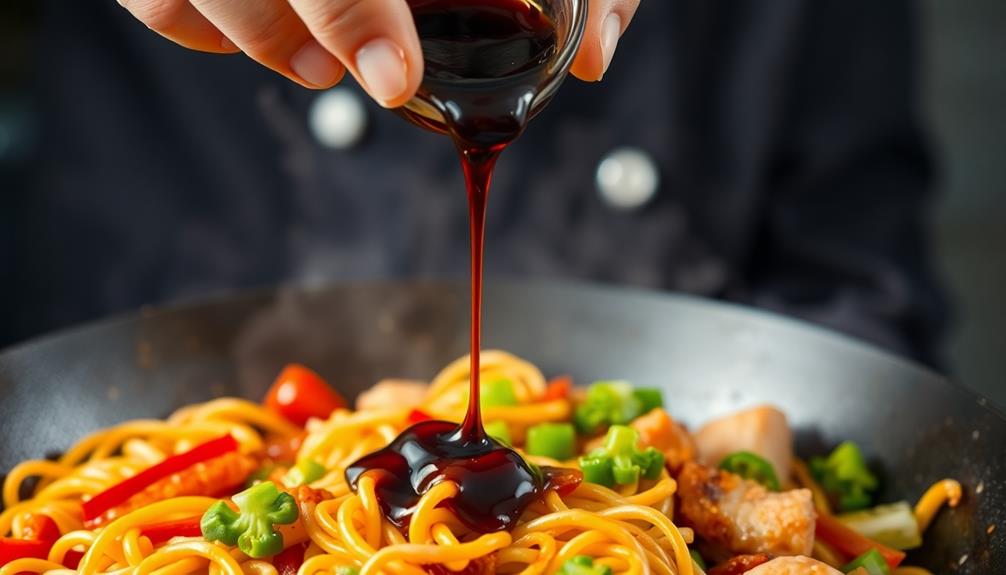
With the vegetables sizzling away, it's time to amp up the flavor! Grab your trusty bottle of soy sauce and give it a good shake. Drizzle a few tablespoons over the stir-fried veggies, making sure to coat them evenly. The salty, umami-rich soy sauce will infuse the dish with a delightful depth of flavor.
Next, it's time to add some seasonings! Sprinkle in a pinch of garlic powder and a dash of onion powder. These aromatic spices will lend a warm, savory note to the chow mein.
Don't forget a sprinkle of ground ginger, too – it'll give the dish a zesty kick. Finally, a sprinkle of white pepper will add a subtle heat that'll make your taste buds tingle.
Stir everything together until the flavors meld and the seasonings are evenly distributed. Now your chow mein is bursting with flavor, ready to be served up hot and delicious!
Step 4. Add Noodles and Toss

Toss in the ready-to-go noodles, gently incorporating them into the vibrant veggie mixture. Use your tongs or a pair of chopsticks to carefully distribute the noodles, making sure each strand gets coated in the savory soy sauce and spices.
Don't be afraid to get in there and really mix it all together – you want the flavors to meld and the noodles to be evenly dispersed throughout the dish.
Once the noodles are nicely incorporated, keep tossing and tossing. This helps the noodles soak up all the delicious saucy goodness.
You'll know you've done it right when the noodles are glistening and the whole thing looks like a colorful, irresistible jumble. To finish off this delicious dish, sprinkle some chopped cilantro and green onions on top for an added burst of freshness. Serve the noodles alongside the delicious cumin lamb recipe for a complete and satisfying meal that will impress any guest. They’ll be begging you for the recipe!
Taste a noodle or two to check the seasoning, adding a sprinkle more soy sauce or a dash of sesame oil if needed.
Then it's time to dig in and enjoy your homemade chow mein masterpiece!
Step 5. Serve Immediately While Hot

Once you've tossed the noodles to your satisfaction, it's time to serve your chow mein immediately while it's hot! Pair your delicious chow mein with a side of traditional dim sum dishes, like steamed dumplings or crispy spring rolls, for a complete and satisfying meal. The savory flavors of the noodles complement the bite-sized treats perfectly, creating an authentic and well-rounded dining experience. Don’t forget to offer some soy sauce or chili oil on the side for an extra kick!
This is the best part – you get to enjoy the sizzling flavors and aromas of your freshly cooked dish. Scoop up generous portions of the noodles and veggies, making sure to get a little bit of everything in each serving.
The key is to serve it piping hot, so your family and friends can dive right in and savor each bite. Don't let it sit around and cool off – that would be a shame! The noodles are at their absolute best when they're still steaming.
Serve your chow mein in bowls or on plates, and provide chopsticks or forks for easy eating. Your guests will love the fragrant, mouthwatering dish you've prepared.
Final Thoughts
As you savor the final bites of this delectable dish, let the flavors linger on your palate.
You've now experienced the perfect balance of salty, savory, and slightly sweet notes that make chow mein so irresistible. The tender noodles, crunchy vegetables, and juicy protein have come together seamlessly, leaving your taste buds thoroughly satisfied.
While the cooking process may have taken some time and effort, the payoff is well worth it.
Whipping up a batch of homemade chow mein allows you to customize the ingredients to your personal preferences, ensuring every forkful is exactly how you like it.
Plus, the aroma wafting through your kitchen is sure to have your family eagerly awaiting their turn.
Frequently Asked Questions
What Is the Origin of the Name "Chow Mein"?
You're curious about the origin of the name "chow mein," aren't you? The term comes from the Cantonese words "chāu" meaning "fried" and "miàn" meaning "noodles." So "chow mein" literally translates to "fried noodles."
Is Chow Mein a Traditional Chinese Dish?
While chow mein may seem like a traditional Chinese dish, its origins are actually more complex. It's a dish that's been influenced by various culinary traditions and adapted to suit different tastes and preferences.
Can Chow Mein Be Made Vegetarian or Vegan?
Yes, you can make chow mein vegetarian or vegan. By omitting the meat and using plant-based proteins like tofu, tempeh, or mushrooms, you can create a delicious and satisfying meatless version of this classic dish.
How Do I Store Leftover Chow Mein?
To store your leftover chow mein, let it cool completely before transferring it to an airtight container. Keep it refrigerated for up to 4 days, and reheat it in the microwave or on the stovetop before serving.
Can I Use Different Types of Noodles for Chow Mein?
You can certainly use different types of noodles for your dish. Feel free to experiment with ramen, udon, or even egg noodles to create your own unique take on this classic stir-fry.
